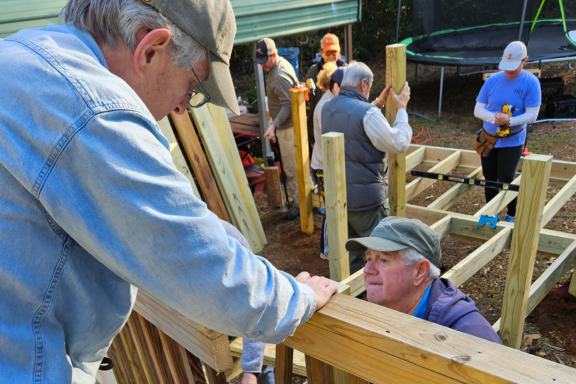It began with a simple request. Would Prince George Winyah commit to building a handicap ramp for a family in Georgetown County?
The request came from Charlie Ball who, at the time, was the Executive Director of Friendship Place, a soup kitchen in Georgetown. He was seeing an increase in ramp requests due to the health conditions and mobility issues individuals in the county were experiencing. So, I called my friend Pete Williams.
We committed to build the ramp without even consulting the church. The year was 2011, and we built one ramp that year. We built another one in 2012 and none in 2013!
Fast forward to 2025 and our group, now known as the Hammerheads, just completed our 100th ramp.
After each request, Pete and I visit the site to meet with the prospective recipient to determine whether the ramp should be permanent or temporary based on their medical situation. Do they need it for just six months during rehab? If, so we refer them to Sel Hemingway, the father of one of our Hammerheads, whose group can install a temporary aluminum ramp.
If they need a permanent ramp, that falls to the Hammerheads. During the site visit, Pete and I will sketch where the ramp can be placed, take measurements and pictures, and from that information Pete will generate work drawings. Though neither of us is an architect we both have engineering backgrounds (Georgia Tech and Clemson) but Pete’s clearly the brains of our group.
After we’d built about 10 ramps, he looked at me and said, “There’s got to be a better way. We’ve got to streamline this.”
Each ramp consists of several distinct components: a platform at the door or stoop; a section of ramp; another platform where the ramp will change direction (90 or 180 degrees) and more ramp to the ground. Pete came up with drawings for each component, using stock lengths for minimum waste.
On really involved projects, we might precut some lumber, but our cut person does a great job keeping up with volunteers.
When you bring volunteers into a project the last thing you want is for them to stand around, bored. They want to be busy. My job was to keep them busy but after 100 ramps, when they finish their task, they know what comes next and they instinctively move to it. Now when volunteers arrive, they break into teams of two or three. Each group gets a laminated sheet for their component and goes to work.
One of our women volunteers is so into this she asked for an impact driver for Christmas! So cool!
We meet current ADA and county building standards, and all ramps will accommodate EMS personnel and gurneys.
Our requests come from medical referrals, nonprofits, and word of mouth and all of the projects take place on Saturday mornings and are typically completed by lunch. A standard ramp will cost approximately $1,100 and there is no cost to the recipient. Our funding comes from the church outreach budget and the Bunnelle Foundation of Georgetown.
We tell our volunteers no experience is needed, only a willingness to leave your comfort zone and help change someone’s life in four hours. We currently have 25 volunteers, men and women ages 18 to 75, and once the request for volunteers goes out, usually six or seven per ramp, the list fills up quickly.
If other groups would like to start a similar ministry, we will gladly share what we’ve learned over the years. Or, better yet, come see for yourself and help on one of our projects. We believe everyone should be able to safely enter and leave their home, and we look forward to the next 100 ramps.
By Bill Brabson, Prince George Winyah, Georgetown.
This article first appeared in the Summer 2025 edition of the Jubilate Deo. View the Jubilate Deo.

